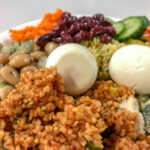Roggen Soja Schrotbrot (Rye and Soy Meal Bread)
Introduction
Roggen Soja Schrotbrot is a traditional German bread combining the robust flavors of rye and the nutritious benefits of soy meal. This bread is known for its dense texture and hearty taste, making it a perfect accompaniment to soups, cheeses, and cold cuts. In this recipe, we’ll explore the steps to create this wholesome loaf from scratch.
Ingredients
- Rye Flour: 400 grams. Rye flour gives the bread its characteristic flavor and dense texture.
- Soy Meal: 100 grams. Soy meal adds protein and a nutty flavor.
- Whole Wheat Flour: 100 grams, for added texture and nutrition.
- Sourdough Starter: 150 grams. A rye sourdough starter is ideal for this bread.
- Water: 350 ml, lukewarm.
- Salt: 10 grams, to enhance flavor.
- Yeast: 7 grams (or 20 grams fresh yeast), to help the bread rise.
- Molasses: 1 tablespoon, for a slight sweetness and darker color.
- Caraway Seeds: Optional, for a traditional flavor.
Equipment
- Mixing bowls
- Dough scraper
- Kitchen scale
- Bread loaf pan (or a baking stone for a free-form loaf)
- Oven
- Kitchen towel
Preparation
- Sourdough Starter Activation: If your sourdough starter is from the fridge, activate it by feeding it with equal parts rye flour and water. Let it sit at room temperature for 6-12 hours until bubbly.
- Mixing the Dough: In a large bowl, combine the rye flour, soy meal, whole wheat flour, and caraway seeds (if using). In another bowl, mix the lukewarm water, molasses, and yeast. Let it sit for 10 minutes. Then, add the sourdough starter and the yeast mixture to the dry ingredients. Mix until a sticky dough forms.
- First Rise: Cover the bowl with a kitchen towel and let the dough rise for about 2 hours at room temperature. The dough will not double in size like wheat dough but should show some expansion.
- Shaping the Loaf: After the first rise, gently shape the dough to fit your loaf pan. If you prefer a free-form loaf, shape it on a floured surface and transfer it to a parchment-lined baking tray.
- Second Rise: Cover the shaped dough and let it rise for another hour.
- Preheating the Oven: Preheat your oven to 220°C (430°F) at least 30 minutes before baking. If using a baking stone, place it in the oven during preheating.
- Baking: Place the bread in the oven. If using a loaf pan, bake for about 45-50 minutes. For a free-form loaf, the baking time might be slightly less. The bread is done when it sounds hollow when tapped at the bottom.
- Cooling: Remove the bread from the oven and let it cool on a wire rack. Wait for at least 2 hours before slicing to allow the flavors to develop.
Tips for Success
- Sourdough Starter: Using a rye sourdough starter enhances the flavor. If unavailable, a wheat starter can be used, but the flavor profile will be slightly different.
- Hydration: Rye flour absorbs more water than wheat flour. If the dough seems too dry, add a little more water.
- Handling the Dough: Rye dough is stickier than wheat dough, so wet your hands when handling it.
- Slicing: Use a sharp, serrated knife to slice the bread. Rye bread can be dense and moist, making it challenging to cut when fresh.
Serving Suggestions
Roggen Soja Schrotbrot pairs wonderfully with strong cheeses, smoked meats, and pickles. It’s also excellent when toasted and served with butter and jam for breakfast.


